Lemon balm tea is your gut's new best friend, offering a soothing and flavorful solution for digestive wellness. Brew this caffeine-free herbal tea using dried or fresh leaves from the lemon balm plant. It's rich in antioxidants and compounds that can calm stomach discomfort, reduce inflammation, and support healthy gut bacteria. To make the perfect cup, steep 1-2 teaspoons of dried leaves (or a handful of fresh ones) in hot water for 5-10 minutes. You can enhance the flavor with honey, lemon, or mint. By incorporating this aromatic tea into your daily routine, you'll discover a natural way to nurture your digestive health and overall well-being.
What Is Lemon Balm Tea?
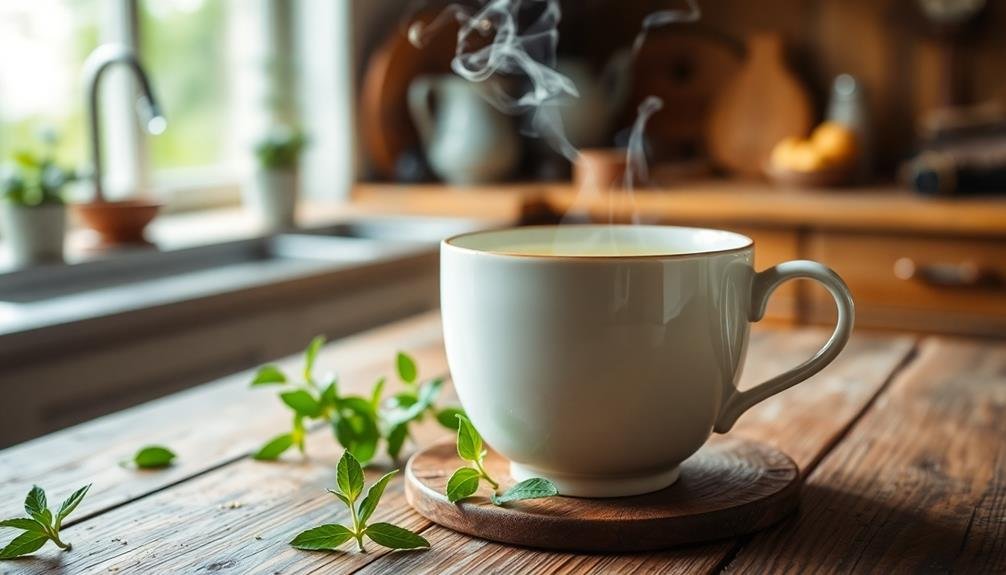
Lemon balm tea is brewed from the leaves of the lemon balm plant, a member of the mint family. This aromatic herb, scientifically known as Melissa officinalis, has been used for centuries in traditional medicine and culinary applications. When steeped in hot water, the leaves release their distinct lemony flavor and aroma, creating a soothing and invigorating beverage.
You'll find that lemon balm tea has a light, citrusy taste with subtle minty undertones. It's caffeine-free, making it an excellent choice for those looking to reduce their caffeine intake or enjoy a calming drink before bedtime. The tea is rich in antioxidants and contains various compounds that contribute to its potential health benefits.
To brew lemon balm tea, you can use fresh leaves from your garden or dried leaves available in tea bags or loose-leaf form. Simply steep 1-2 teaspoons of dried leaves (or a handful of fresh leaves) in hot water for 5-10 minutes.
You can adjust the strength to your liking by steeping for a shorter or longer time. Enjoy it hot or iced, and feel free to add honey or lemon for extra flavor.
Gut Health Benefits
When it comes to gut health, lemon balm tea offers several potential benefits. This aromatic brew can help soothe digestive discomfort and promote overall gut wellness.
Lemon balm contains compounds that may reduce inflammation in your digestive tract, potentially easing symptoms of conditions like irritable bowel syndrome (IBS) and acid reflux.
You'll appreciate lemon balm tea's ability to:
- Calm stomach cramps and bloating
- Reduce nausea and indigestion
- Support healthy gut bacteria growth
By drinking this tea regularly, you're supporting your gut's natural balance and function.
Lemon balm's antispasmodic properties can help relax your digestive muscles, easing tension and promoting smoother digestion. This can be particularly beneficial if you suffer from frequent stomach upset or gas.
Additionally, lemon balm tea may help stimulate the production of digestive enzymes, enhancing your body's ability to break down food and absorb nutrients.
Its gentle, calming effect on your digestive system can also help reduce stress-related digestive issues. By incorporating lemon balm tea into your routine, you're taking a proactive step towards better gut health and overall well-being.
Harvesting and Drying Lemon Balm
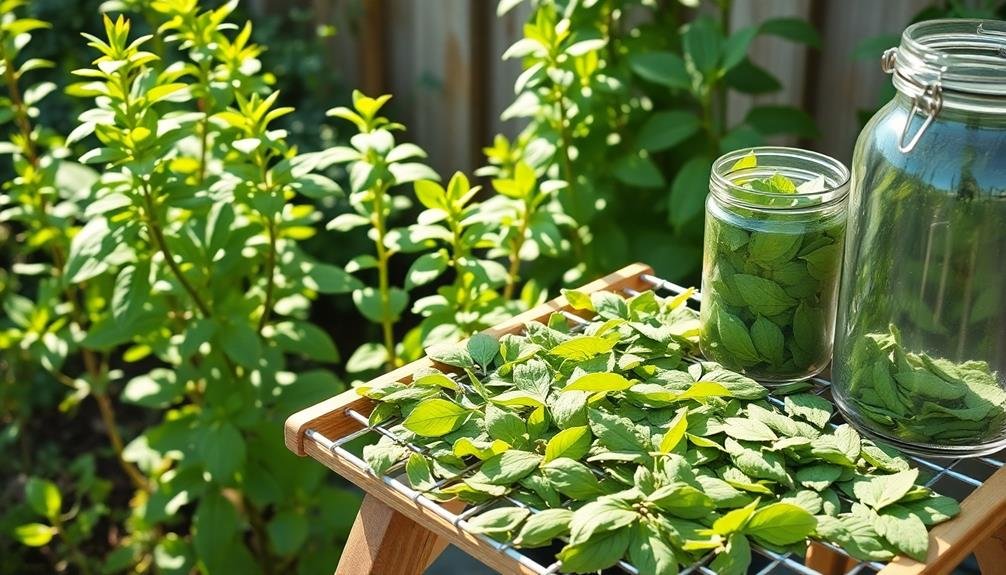
To harvest lemon balm for tea, you'll want to pick the leaves just before the plant flowers, when their flavor is most potent.
Cut stems about 2 inches above the ground using clean, sharp scissors, and avoid taking more than a third of the plant at once.
You can dry the leaves by hanging bundles upside down in a warm, dark place or by spreading them on screens in a single layer, turning them daily until they're crisp.
Best Harvesting Time
For ideal flavor and potency, harvest lemon balm just before the plant begins to flower. This usually occurs in late spring or early summer, depending on your climate. At this stage, the leaves contain the highest concentration of essential oils, giving your tea the best taste and therapeutic benefits.
To determine the perfect harvesting time, keep an eye out for these signs:
- The stems have grown tall and leafy
- Leaf color is vibrant green
- Small flower buds are forming but haven't opened yet
You'll want to harvest in the morning after the dew has dried but before the sun becomes too intense. This timing guarantees that the plant's oils are at their peak. Cut the stems about 2-3 inches above the ground, leaving enough foliage for the plant to regrow.
If you've missed the pre-flowering stage, don't worry. You can still harvest throughout the growing season, though the flavor might be slightly less intense.
Regular harvesting actually encourages bushier growth, so you'll have a continuous supply for your tea. Just remember to stop harvesting about a month before the first frost to allow the plant to prepare for winter.
Proper Cutting Techniques
Once you've identified the ideal time to harvest, proper cutting techniques are essential for maintaining plant health and ensuring the best quality lemon balm for your tea.
Begin by selecting clean, sharp scissors or pruning shears to prevent damage to the plant. Cut the stems about 2-3 inches above the ground, just above a leaf node. This encourages new growth and helps the plant maintain its shape.
Focus on harvesting the younger, tender leaves and stems, as they contain the highest concentration of essential oils. Avoid cutting more than one-third of the plant at a time to prevent stress and allow for regrowth. If you're harvesting from multiple plants, alternate between them to distribute the impact.
After cutting, gently shake the stems to remove any insects or debris. Don't wash the leaves, as this can reduce their flavor and aroma.
Instead, lay the cut stems on a clean, dry surface in a single layer. Remove any damaged or discolored leaves, then bundle the stems loosely with twine. Hang these bundles upside down in a warm, dry, and well-ventilated area away from direct sunlight to preserve the lemon balm's potency for your tea.
Drying Methods Explained
Drying methods play a crucial role in preserving lemon balm's flavor and medicinal properties for tea. You've got several options to choose from, each with its own advantages.
Air-drying is the most traditional and cost-effective method. Simply tie small bundles of lemon balm stems and hang them upside down in a warm, dry, and well-ventilated area for about a week.
For a quicker approach, you can use a food dehydrator. Set it to a low temperature (around 95°F to 115°F) and dry the leaves for 2-4 hours. This method helps retain more of the plant's essential oils.
If you're in a hurry, oven-drying is an option, but be cautious as it can easily overheat the delicate leaves.
Whichever method you choose, verify your lemon balm is completely dry before storing. Properly dried leaves should be:
- Crisp and crumbly to the touch
- Dark green in color
- Strongly aromatic when crushed
Store your dried lemon balm in airtight containers away from direct sunlight to maintain its potency.
When done correctly, dried lemon balm can retain its flavor and benefits for up to a year.
Brewing the Perfect Cup
To brew the perfect cup of lemon balm tea, you'll need to pay attention to steeping time and temperature.
You'll want to use water that's just below boiling and steep the leaves for about 5-10 minutes, depending on your desired strength.
If you're looking to enhance the flavor, you can try adding honey, lemon slices, or a sprig of fresh mint to your brew.
Steeping Time and Temperature
Brewing the perfect cup of lemon balm tea requires attention to steeping time and temperature. For ideal flavor and health benefits, steep your lemon balm tea for 5-10 minutes in water that's just below boiling, around 200°F (93°C). This temperature allows the delicate leaves to release their aromatic oils without becoming bitter.
If you're using fresh lemon balm leaves, you'll want to steep them for a bit longer, about 10-15 minutes, to fully extract their essence. For dried leaves, stick to the shorter end of the range. Remember, the longer you steep, the stronger the flavor will be, but be cautious not to oversteep, as this can lead to a bitter taste.
Here are some key points to keep in mind:
- Use a tea infuser or strainer to easily remove the leaves after steeping
- Cover your cup while steeping to prevent the volatile oils from escaping
- Adjust steeping time based on your personal taste preferences
Flavor Enhancing Additions
While the perfect steeping time and temperature lay the foundation for a great cup of lemon balm tea, you can elevate your brew with carefully chosen flavor enhancers. Consider adding a slice of fresh lemon or a squeeze of lemon juice to amplify the citrusy notes and boost vitamin C content. For a touch of sweetness, try a drizzle of honey or a small amount of stevia. These natural sweeteners complement lemon balm's flavor profile without overpowering it.
If you're looking to create a more complex taste, experiment with other herbs. A sprig of fresh mint can add a cooling sensation, while a few leaves of holy basil (tulsi) introduce a subtle spiciness. For a calming blend, mix in some chamomile flowers.
You can also infuse your lemon balm tea with a cinnamon stick or a few slices of fresh ginger for warmth and depth.
Don't forget about fruity additions. A handful of fresh berries or a splash of unsweetened cranberry juice can provide a tart contrast to lemon balm's mild flavor. For a revitalizing summer drink, add cucumber slices and serve over ice.
Flavor Combinations and Enhancements
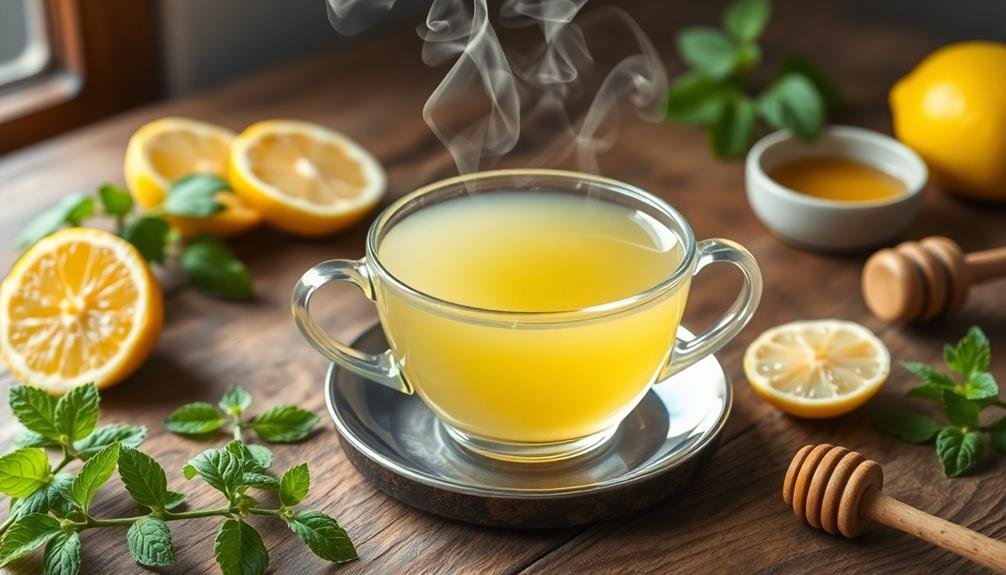
Many tea enthusiasts enjoy experimenting with lemon balm tea to create unique flavor profiles. You can enhance its naturally mild, lemony taste by combining it with other herbs, fruits, or spices.
Try steeping lemon balm with chamomile for a soothing bedtime blend, or mix it with peppermint for a revitalizing digestive aid. For a zesty twist, add a slice of fresh ginger or a sprinkle of turmeric to your brew.
To elevate your lemon balm tea experience, consider these flavor combinations:
- Lemon balm + lavender + honey: A calming blend with floral notes
- Lemon balm + raspberry + vanilla: A fruity, dessert-like infusion
- Lemon balm + green tea + lemongrass: An energizing, citrusy mix
Don't be afraid to get creative with your additions. A splash of apple juice can add natural sweetness, while a cinnamon stick can introduce warmth and complexity.
If you're feeling adventurous, try cold-brewing lemon balm tea and adding fresh mint leaves for a revitalizing summer drink. Remember, the key to finding your perfect blend is experimentation, so don't hesitate to try new combinations and adjust proportions to suit your taste preferences.
Precautions and Potential Side Effects
Safety should be a top priority when consuming lemon balm tea. While generally considered safe, you should be aware of potential side effects and precautions.
If you're pregnant or breastfeeding, consult your healthcare provider before drinking lemon balm tea, as its effects on fetal development and infants aren't fully understood.
If you have thyroid issues, use caution, as lemon balm may interfere with thyroid hormone production. Those taking sedatives or thyroid medications should also consult their doctor, as lemon balm can interact with these drugs.
Be mindful of dosage; excessive consumption may lead to nausea, dizziness, or headaches.
If you're scheduled for surgery, stop drinking lemon balm tea at least two weeks prior, as it may increase the effects of anesthesia.
Individuals with glaucoma should avoid lemon balm, as it can increase eye pressure. If you experience allergic reactions like skin rashes or difficulty breathing after consuming lemon balm tea, discontinue use immediately and seek medical attention.
Always start with small amounts to test your body's reaction, and don't exceed recommended dosages.
Incorporating Into Daily Routine
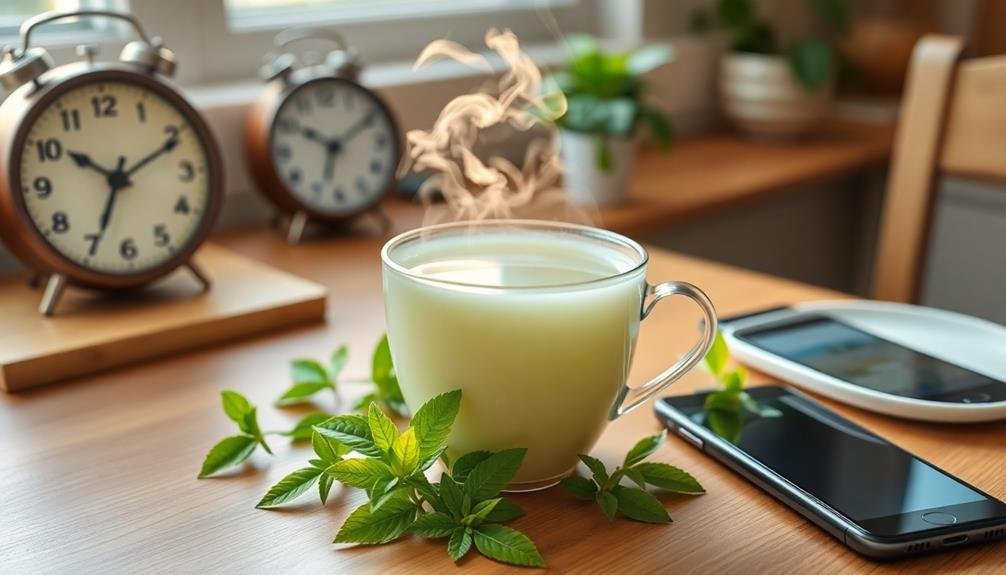
For those looking to enjoy the benefits of lemon balm tea regularly, incorporating it into your daily routine can be simple and rewarding. Start by choosing a consistent time to brew and drink your tea, whether it's in the morning to boost your mood or in the evening to promote relaxation.
You can easily prepare a large batch and store it in the refrigerator for up to three days, making it convenient to grab and go.
To make lemon balm tea a habit, try these strategies:
- Set a daily reminder on your phone or calendar
- Keep your tea supplies visible and easily accessible
- Pair tea drinking with another daily activity, like reading or meditation
Experiment with different ways to enjoy lemon balm tea. Add a squeeze of fresh lemon or a drizzle of honey for extra flavor.
You can also combine it with other herbal teas like chamomile or peppermint for additional benefits. If you're not a fan of hot drinks, try making a revitalizing iced lemon balm tea during warmer months.
Frequently Asked Questions
Can Lemon Balm Tea Help With Sleep Disorders?
Yes, lemon balm tea can help with sleep disorders. It's known for its calming properties, which may reduce anxiety and improve sleep quality. You'll find it easier to relax and drift off when you drink it before bedtime.
Is It Safe to Consume Lemon Balm Tea During Pregnancy?
You should be cautious about consuming lemon balm tea during pregnancy. While it's generally considered safe in small amounts, it's best to consult your healthcare provider first. They'll help you weigh potential benefits against any risks.
How Long Does Dried Lemon Balm Stay Fresh for Tea?
You'll find that dried lemon balm can stay fresh for up to a year when stored properly. Keep it in an airtight container, away from light and moisture. For the best flavor, use it within six months.
Can Lemon Balm Tea Interact With Prescription Medications?
Yes, lemon balm tea can interact with certain medications. You should consult your doctor before drinking it, especially if you're taking thyroid medications, sedatives, or HIV treatments. It's always best to be cautious with herbal remedies.
Is Lemon Balm Tea Effective for Treating Cold Sores?
Yes, lemon balm tea can be effective for treating cold sores. You'll find it may help reduce symptoms and healing time. It's known for its antiviral properties, which can combat the herpes simplex virus causing cold sores.
In Summary
You've now discovered the wonders of lemon balm tea for your gut health. With its soothing properties and delightful flavor, it's an easy addition to your daily routine. Remember to harvest or source quality leaves, brew carefully, and experiment with flavor combinations. While it's generally safe, be mindful of potential side effects. By incorporating this herbal remedy into your life, you're taking a simple yet effective step towards better digestive health and overall well-being.

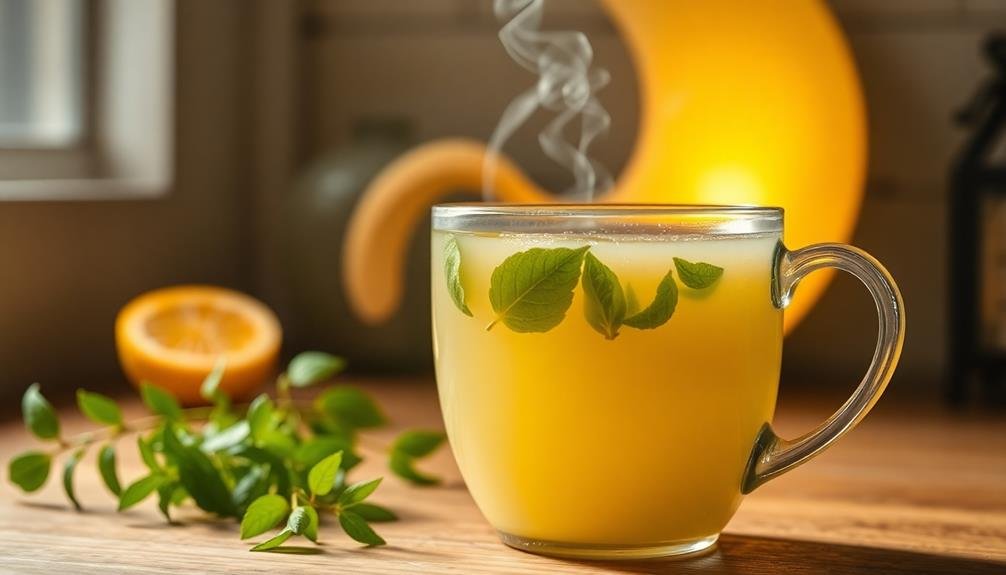
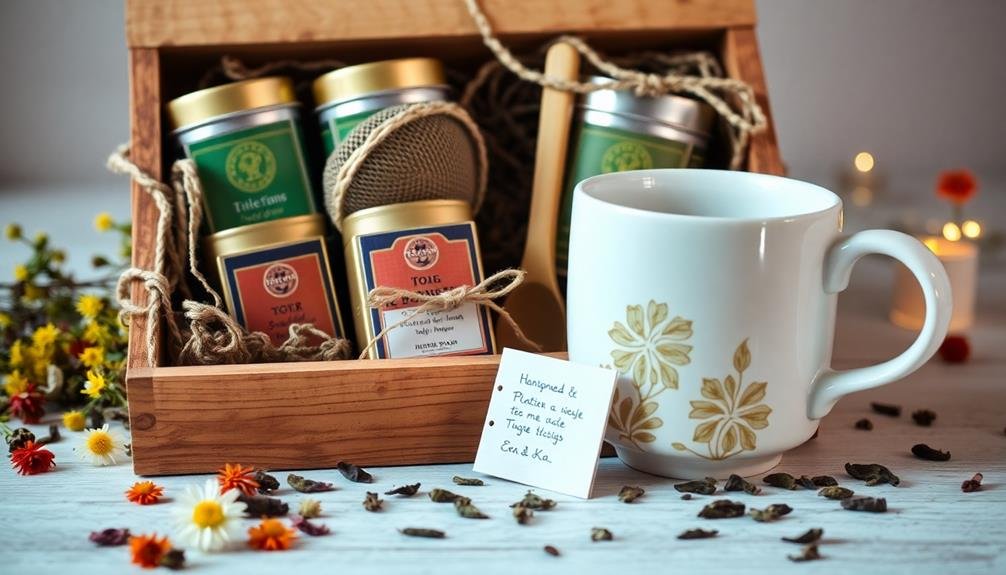


Leave a Reply